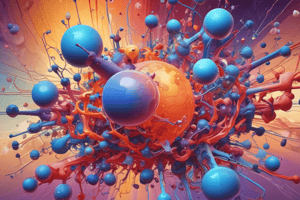Podcast
Questions and Answers
What is an example of a chemical property of a substance?
What is an example of a chemical property of a substance?
- Density
- Flammability (correct)
- Texture
- Color
What factor increases the rate of evaporation?
What factor increases the rate of evaporation?
- Higher humidity
- Lower temperature
- Increased air movement (correct)
- Decreased surface area
What is the main characteristic of particles in a solid state of matter?
What is the main characteristic of particles in a solid state of matter?
- They are widely spaced and free to move in any direction
- They vibrate in place but do not change position (correct)
- They are close together but free to move past one another
- They have a fixed shape but can change volume
What is the term for a property that depends on the amount of substance present?
What is the term for a property that depends on the amount of substance present?
What is an example of an intensive property of a substance?
What is an example of an intensive property of a substance?
What is the state of matter characterized by ionized atoms?
What is the state of matter characterized by ionized atoms?
What is the primary location where evaporation occurs?
What is the primary location where evaporation occurs?
What is an important process in nature that is contributed to by evaporation?
What is an important process in nature that is contributed to by evaporation?
Flashcards are hidden until you start studying
Study Notes
States of Matter
- There are four fundamental states of matter: solid, liquid, gas, and plasma
- Solids:
- Particles are closely packed and have a fixed shape and volume
- Particles vibrate in place but do not change position
- Liquids:
- Particles are close together but are free to move past one another
- Particles have a fixed volume but take the shape of their container
- Gases:
- Particles are widely spaced and are free to move in any direction
- Particles have neither a fixed shape nor a fixed volume
- Plasma:
- A high-energy state of matter where atoms are ionized
- Found in stars, lightning, and neon signs
Properties of Matter
- Physical Properties:
- Characteristics that can be observed or measured without changing the identity of the substance
- Examples: color, texture, odor, melting point, boiling point
- Chemical Properties:
- Characteristics that describe a substance's ability to undergo chemical changes
- Examples: flammability, reactivity with other substances, pH level
- Extensive Properties:
- Properties that depend on the amount of substance present
- Examples: mass, volume, density
- Intensive Properties:
- Properties that do not depend on the amount of substance present
- Examples: temperature, concentration, density
Evaporation
- The process by which a liquid transforms into a gas or vapor
- Occurs at the surface of a liquid, where molecules have enough energy to escape
- Factors that influence evaporation:
- Temperature: higher temperatures increase evaporation rate
- Surface area: increased surface area allows more molecules to escape
- Humidity: lower humidity allows for faster evaporation
- Air movement: increased air movement facilitates evaporation
- Evaporation is an important process in nature, contributing to:
- Water cycle and precipitation
- Weather patterns and climate
- Plant transpiration and photosynthesis
States of Matter
- Four fundamental states of matter: solid, liquid, gas, and plasma
- Solids:
- Fixed shape and volume due to closely packed particles
- Particles vibrate in place but do not change position
- Liquids:
- Particles close together, free to move past one another
- Fixed volume, takes shape of container
- Gases:
- Widely spaced particles, free to move in any direction
- Neither fixed shape nor fixed volume
- Plasma:
- High-energy state of matter with ionized atoms
- Found in stars, lightning, and neon signs
Properties of Matter
- Physical Properties:
- Characteristics observable or measurable without changing substance identity
- Examples: color, texture, odor, melting point, boiling point
- Chemical Properties:
- Characteristics describing substance's ability to undergo chemical changes
- Examples: flammability, reactivity with other substances, pH level
- Extensive Properties:
- Properties dependent on amount of substance present
- Examples: mass, volume, density
- Intensive Properties:
- Properties independent of amount of substance present
- Examples: temperature, concentration, density
Evaporation
- Process by which liquid transforms into gas or vapor
- Occurs at liquid surface, where molecules have enough energy to escape
- Factors influencing evaporation:
- Temperature: higher temperatures increase evaporation rate
- Surface area: increased surface area allows more molecules to escape
- Humidity: lower humidity allows for faster evaporation
- Air movement: increased air movement facilitates evaporation
- Evaporation's importance in nature:
- Contributes to water cycle and precipitation
- Influences weather patterns and climate
- Crucial for plant transpiration and photosynthesis
Studying That Suits You
Use AI to generate personalized quizzes and flashcards to suit your learning preferences.




